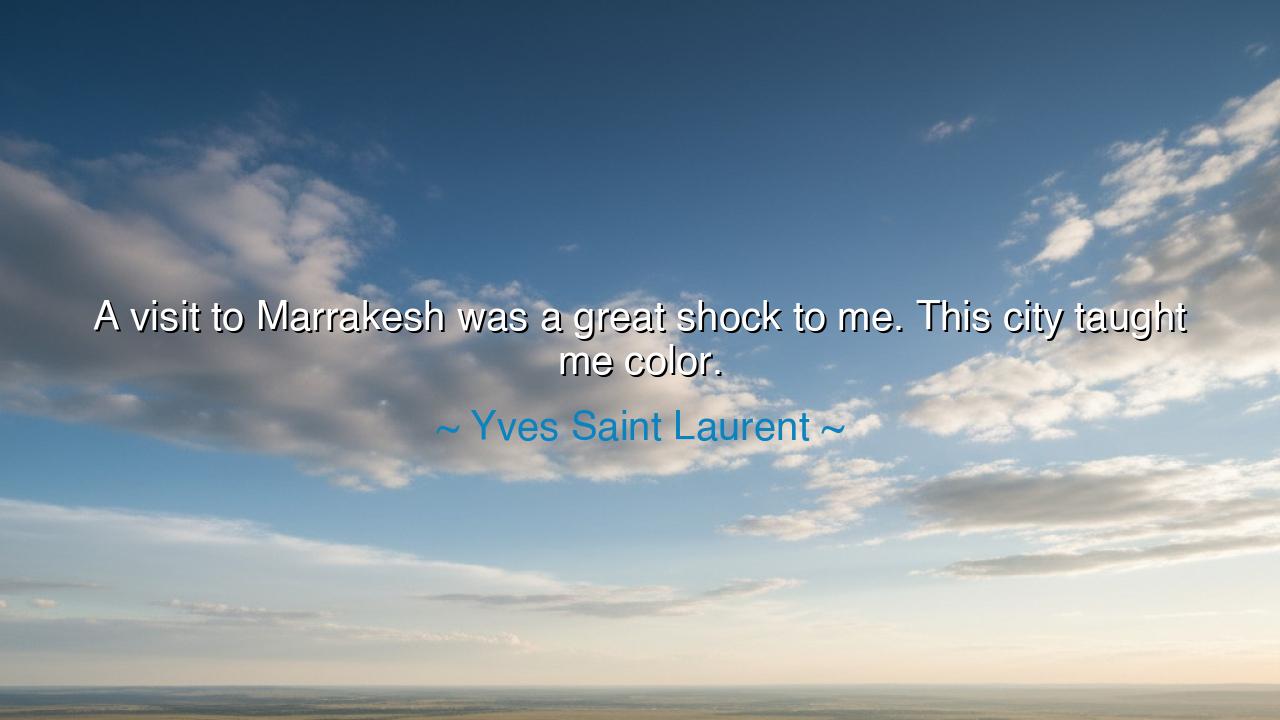
A visit to Marrakesh was a great shock to me. This city taught me






When Yves Saint Laurent uttered the words, “A visit to Marrakesh was a great shock to me. This city taught me color,” he spoke not only as a designer but as a man awakened. For in that moment, the legendary creator was not merely describing a journey across continents — he was speaking of a rebirth of the soul through color, a revelation that shattered the grey walls of routine and opened his eyes to the living fire of the world. In Marrakesh, he did not simply see color; he was seen by color — consumed, transformed, and renewed by it.
Before this encounter, Yves had lived in the pale world of Parisian elegance, a world painted in soft shadows and delicate restraint. He was a master of form, of line and balance, but there was a yearning for vitality hidden beneath the discipline of couture. Then came Marrakesh — the city of sun and dust, of blue courtyards and red earth, of ochre walls that burn beneath the afternoon light. There, color ceased to be an accessory; it became the language of life itself. The shock he spoke of was not a jarring discomfort but a spiritual awakening — the sudden recognition that beauty could be wild, ungoverned, and alive.
Like a poet seeing dawn for the first time, Saint Laurent walked through the streets of Marrakesh and learned what no academy could teach. The scarlet of spice, the sapphire of mosaic, the emerald of palm and garden — each hue sang to him, reminding him that color is not decoration but emotion made visible. In those moments, he learned that art, like life, must not merely be correct; it must be courageous. And so his designs changed forever. The muted tones of his Paris years gave way to bold, defiant hues — to the red of the desert, the blue of Majorelle, the gold of sunlit walls. His art became a celebration of the world’s heartbeat.
The ancients would have understood his revelation well. For did not the Greek philosopher Plato say that the soul remembers through beauty? Marrakesh, for Saint Laurent, was the place where his soul remembered. It remembered that color is the breath of the divine, the way the world speaks directly to the heart. Just as the sculptors of Egypt used lapis and gold to honor their gods, just as the artisans of Byzantium filled their mosaics with the light of heaven, Yves found in Marrakesh a truth that transcended fashion: that to create beauty, one must first be moved by the world.
There is a story told of him, standing in the Jardin Majorelle, the garden he would later restore and make his sanctuary. Surrounded by cobalt walls and orange blossoms, he wept. Not from sorrow, but from the overwhelming joy of seeing — truly seeing — the fullness of life. “Before Marrakesh,” he once said, “everything was black.” After Marrakesh, everything was alive. This was not merely a change of palette; it was a transformation of being. The city had taught him that color is freedom, that creation begins when we dare to let the world’s intensity pass through us unguarded.
So, what lesson shall we draw from this revelation of color? It is this: do not live your life in muted tones. Seek out the places, the people, and the experiences that shock you into seeing anew. Whether it is a city, a piece of music, or a moment beneath the open sky — let yourself be undone by beauty. Allow the unexpected to become your teacher, as Marrakesh was to Yves Saint Laurent. For the soul grows pale when it fears the unknown; it grows radiant when it walks into the fire of discovery.
In the end, the teaching of Marrakesh is not about paint or cloth — it is about perception. The colors were always there; only his eyes had changed. So it must be with us. When the world appears dull or empty, it is not the world that has lost its color, but our hearts that have dimmed. Go, therefore, and seek your Marrakesh — the place or passion that awakens your sleeping senses. Let life teach you color again, until every moment burns bright with meaning, and you can say, as Yves once did, with awe and gratitude: “This city — this experience — has taught me to see.”






AAdministratorAdministrator
Welcome, honored guests. Please leave a comment, we will respond soon